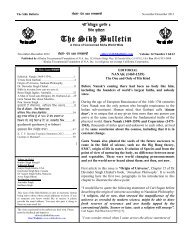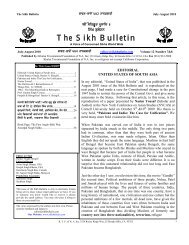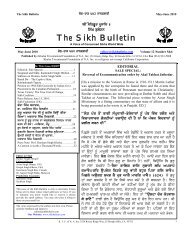hirmMdr ik drbwr swihb - The Sikh Bulletin
hirmMdr ik drbwr swihb - The Sikh Bulletin
hirmMdr ik drbwr swihb - The Sikh Bulletin
You also want an ePaper? Increase the reach of your titles
YUMPU automatically turns print PDFs into web optimized ePapers that Google loves.
<strong>The</strong> S<strong>ik</strong>h <strong>Bulletin</strong> mwG-Pgx 542 nwnkSwhI January-February 2011<br />
GURU GOBIND SINGH IN THE EYES OF<br />
NON – SIKH HISTORIANS<br />
Compiled by Sawan Singh Principal (Retired)<br />
10561 Brier Lane, Santa Ana, California 92705.<br />
714 397 6316<br />
sawansingh85@gmail.com<br />
Syad Muhammad Latif, a famous historian, writes in<br />
‘History of the Panjab’ (1989 edition) :<br />
“Historians agree in praising the great merits of Guru<br />
Govind Singh. In him were united qualities of a<br />
religious leader and a warrior. He was a lawgiver in the<br />
pulpit, a champion in the field, a king on his masnad, a<br />
faqir in the society of the Khalsa. He was the right man<br />
for the needs of the time”. (Page 270)<br />
“His preserving endurance in the midst of calamities<br />
and disasters was equal to his bravery and valour in the<br />
field, and , although he did not live to see his great ends<br />
accomplished, yet it acknowledged on all the hands that<br />
the conversion of a band of undisciplined Jats (given to<br />
rapine and plunder or to agricultural pursuits) into a<br />
body of conquerors and a political corporation was due<br />
entirely to the genius of Govind (Singh), whose history<br />
is closely interwoven with that of S<strong>ik</strong>hs as a nation.<br />
Page (271)<br />
JD Cunningham, an eminent historian, writes in his<br />
book, “History of the S<strong>ik</strong>hs” (1915 edition):<br />
“<strong>The</strong> last apostle of the S<strong>ik</strong>hs did not live to see his own<br />
ends accomplished, but he effectually roused the<br />
dormant energies of a vanquished people and filled<br />
them with a lofty although fitful longing for social<br />
freedom and a national ascendancy, the proper adjuncts<br />
of that purity of worship, which had been preached by<br />
Nanak”.( Page 75.)<br />
Duncan Greenless, a famous historian, has written in<br />
his book' <strong>The</strong> Gospel of the Guru Granth Sahib (<br />
1975):<br />
“Circumstances in the country had changed greatly;<br />
India was under the ruthless bigot Aurangzeb, and<br />
there was no constitution, which could protect her<br />
people from his brutalities. Under him Hindus had no<br />
legal rights, and their temples burnt.<br />
<strong>The</strong>re was nothing else to do but to submit l<strong>ik</strong>e cowards<br />
or the resist l<strong>ik</strong>e men. <strong>The</strong> Guru was forced into<br />
resistance by the incessant attacks of jealous Hill Rajas<br />
who could not tolerate the rise of S<strong>ik</strong>hism beside them;<br />
he used violence and the sword as the surgeon when<br />
all the means have failed takes up a knife. <strong>The</strong> evil of<br />
the day could be combated only in that way.” (Page<br />
XCiX)<br />
W. Owen Cole in his book ‘S<strong>ik</strong>hism and its Indian<br />
Context’ 1469-1208 (1984 edition, London) writes:<br />
It is not to deny the importance of either religion or the<br />
struggle for freedom in his life, but it is to assert that<br />
his desire was for conditions in which his people could<br />
develop their way of life and worship in peace. Page<br />
266.<br />
Sir Gokal Chand Narang writes in his book<br />
‘Transformation of S<strong>ik</strong>hism’ (1960 ):<br />
“<strong>The</strong> seed, which blossomed in the time of Guru<br />
Goving Singh, had been sown by (Guru) Nanak and<br />
watered by his successors. <strong>The</strong> sword which carved<br />
the Khalsa’s way to the glory was undoubtedly,<br />
forged by Guru Govind [Singh] , but the steel had<br />
been provided by Guru NanaK---.”( Page 17.)<br />
Hari Ram Gupta, a very famous historian of the<br />
Punjab History writes in his book, ‘History of the<br />
S<strong>ik</strong>hs Volume 1’ (1984 edition):<br />
“<strong>The</strong> Guru gave the Khalsa the social idea of equality<br />
and close brotherhood. <strong>The</strong>re was to be no distinction<br />
of birth, caste, and class of colour. All were equal in<br />
social status, and had the same rights and privileges.<br />
He thus enunciated ninety years earlier the principles<br />
of liberty, equality and fraternity which formed the<br />
bedrock of French Revolution.”(Page 282.)<br />
“<strong>The</strong> Guru’s four acts of crowing glory are : (a)<br />
creation of Khalsa, (b) bestowal of political<br />
sovereignty on the Khalsa, (c) the selection of<br />
Banda Bhadur for the establishment of the Khasa<br />
rule and (d) declaring the Holy GranthI as the<br />
eternal guru.” ( Page 337. )<br />
Anil Chandra Banerjee, an eminent historian from<br />
Bengal, writes in his book <strong>The</strong> S<strong>ik</strong>h Gurus and the<br />
S<strong>ik</strong>h Religion :<br />
“His performance as a war leader is not to be judged<br />
by his apparent failure to humble his enemies. He<br />
prepared the ground for the war of independence and<br />
the emergence of the S<strong>ik</strong>h State after his death.”<br />
( Page 341)<br />
“ <strong>The</strong> new system of initiation, the abolition of<br />
K. T. F. of N. A. Inc. 3524 Rocky Ridge Way, El Dorado Hills, CA. 95762 12

















